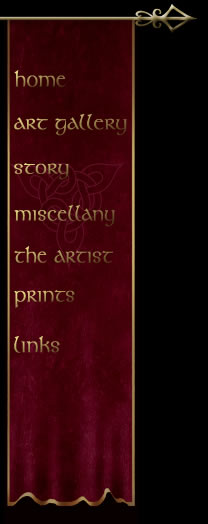So how does one
go about drawing a character? When asked, my usual advice is something to
the tune of sketch guidelines first. What does that mean? Well, if
you'll bear with me, I'll explain and illustrate.
Keep in mind,
there is no precise 'correct' way to go about drawing. Over time, most artists
will develop their own personal techniques that suit their own personal style.
The following is simply a method I find effective for drawing characters when
no live, nude models are available to stand around and pose for me (which
is usually).
Now, on with the show.
1.
2.
3.
1.
What
are guidelines?
One of the fundamental principles of drawing is that everything can be deconstructed
into basic shapes -- primarily spheres, boxes, cones and cylinders.
Why does this matter? Because if you can break anything down into basic shapes,
it follows that you can construct anything using basic shapes as guides.
Why
use guidelines?
The poor
wretch on the left of the illustration is a victim of outline-drawing, a method
many beginning artists will tend to use without realizing the disadvantage.
Not only does this result in flat-looking characters, but it also makes it difficult
to create interesting or dynamic poses. When you sketch guidelines first, you
can plan out your entire drawing before you do any serious work. Furthermore,
the contours of the guide shapes will help to lend a certain 3-dimensional quality
to the end result. Also, if you don't use guidelines, no one will ever like
you.
More
guideline propaganda.
Here we have the simplified skeleton
-- a popular tool for drawing human characters. If you've
ever put painstaking work into a drawing only to discover half way through that
the arm is too short, or the head is too big, or that the legs will have to
extend off the paper, then this little number is for you. Plotting out your
drawing with this type of guide can drastically cut back on the amount of erasing
and revising you have to do after you've already invested a good deal of effort
in your work.
As
you can see here, planning the proportions, pose, and even the personality your
character drawing will have requires only a few simple lines. Guidelines.
In the next part, I'll detail just how I go from this step to a complete character
drawing. Read on!
Part
1
Part
2
Los Esqueletos.
A variety of simple
skeletons for your perusal. This is how I typically start a human character
drawing, but the technique works for just about any type of character.
Note that the neck and spine are one continuous line that arcs from the pelvis
line up through the line representing the shoulders.
2.
Basic
Shapes.
Once
I've laid out my skeletons, I use them to start adding my basic shapes -- putting
meat on their bones so to speak. It helps to think of each shape as a 3-dimensional
object. Around the upper arms, I'm drawing in a cylinder, not just a flat shape.
Around the shoulder joint, I'm drawing a sphere, not just a circle, and so on.
Don't be afraid to get messy about it either.
3.
Connect
the Dots.
In the
next step in the process, I start joining my shapes together with more definitive
lines for the contours of the body. I've started to erase the guidelines I no
longer need, and I've also begun sketching in clothing. Remember that the appearance
of the clothing and the way fabric falls will be determined by the underlying
shape of the body.
4.
Clean-up.
This is probably the longest, most involved step, but it's
much easier to concentrate on the details of your drawing now that the overall
figure is complete. Erase whatever unsightly guidelines are left at this stage,
add the frills, shading and whatever other embellishments you intend.
And
in case you might find it more convenient, I've grouped the four steps together
into one image per character drawing. Just click the thumbnails below.
Fin.

